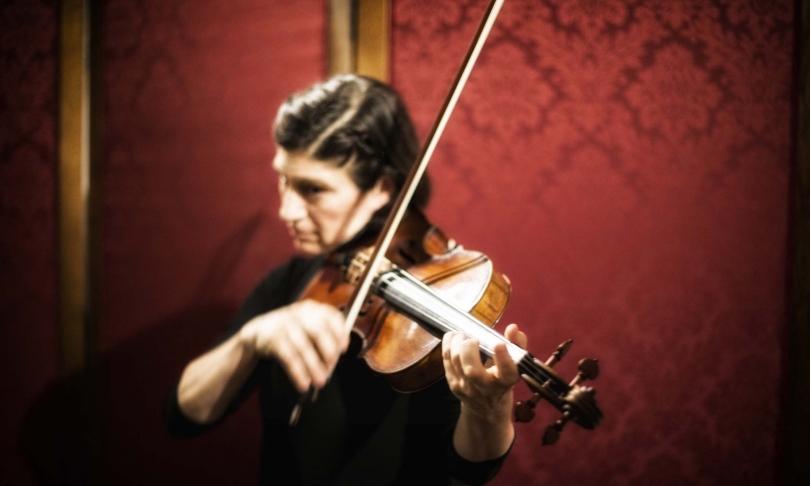
No, it's not a premiere that Kim Kashkashian, one of the greatest viola players of our time, if not the greatest, plays Bach's Suites for Violoncello on her instrument. Others have done that before and recorded it on audio carriers. Since a viola is a whole lot smaller and tuned one octave higher than a cello, it requires an arrangement of the original, so that it can be played on the viola. Through the loss of the low register which gives the cello its "profoundly masculine" character, the arrangement for the viola takes us to a much lighter tonal dimension that has to be illuminated by an interpretive approach that inevitably differs from the interpretive approach of the original for Cello, to be credible. In addition, in the words of the Hungarian composer György Ligeti, "the viola has a peculiar tartness, compact, somewhat hoarse, with the smoky taste of wood, earth and tannic acid through the deep C string. Wikipedia describes the sound of the viola correctly as full, soft, dark to the highest registers, always somewhat melancholic, slightly smoky and slightly nasal. This is contrasted with the fact that the cello with a range of nearly five octaves corresponds to the extent of the male voice, and that its tone over the entire range has almost the same "linear" character without the viola's own tartness and hoarseness.
Bach's Cello Suites not only challenge the viola player with the challenge of harmonizing the viola's own palette of sounds with what the ingenious Thomaskantor has set for an instrument of a deeper pitch. Rather, these suites technically put the highest requirements for the cello as well as for the viola. Above all, they demand an interpreter who is able to penetrate deeply into the content of the composition, to interpret it and to convey the interpretation conclusively to the listeners. Actually, it requires a philosopher on the cello, as in his time Pablo Casals. In this respect, the cello suites by J.S. Bach define something like the Mount Everest for its first conquerors: a nearly insurmountable hurdle to fulfill a truly high goal. The Mount Everest is no longer insurmountable since the mountain tourists queue at its feet. The same applies to Bach's cello suites, which in contrast to Casal's time are nowadays part of the repertoire of young and youngest cellists who are even technically better off than the great Spaniard at the time of his recording of the Bach Suites. However, one cannot basically say the same thing about the penetration of this composition by all of todays cello players; on the contrary, philosophers on the cello are still few. The same situation prevails among the viola players, who have dared, however, so far in comparatively small numbers to get on the Mount Everest of the cello solo compositions.
Kim Kashkashian, deren technische Fähigkeiten außer Frage stehen gelingt es, in die inhaltlichen Geheimnisse der Suiten so tief einzutauchen wie die großen philosophischen Könner am Cello und Schätze zu heben, die sie dann auf der Klangebene den Hörern als schlüssiges Ganzes präsentiert. Dank ihrer technischen Souveränität gelingt es Kim Kashkashian, bei allem Tiefblick in die Komposition jederzeit Spielfreude glaubhaft zu vermitteln und den Eindruck zu schaffen, melodische Einfälle wie frisch improvisiert erklingen zu lassen. Gerne lässt man sich in den Kosmos einbeziehen, den Kim Kashkashian mit ihrer Interpretation der Solo-Suiten aufspannt und wenn sie in der letzten, der sechsten Suite die Klangfarbe ihrer Viola noch ein ganzes Stück erweitert, indem sie eine fünfte Saite aufspannt, ist es als ob der dreidimensionale Kosmos eine vierte Dimension dazugewinnt. Einfach himmlisch.
Kim Kashkashian, whose technical abilities are beyond question, is able to delve into the content secrets of the suites as deeply as the great philosophical masters on the cello and to lift treasures, which she then presents on the sound level to the listeners as a coherent whole. Thanks to her technical sovereignty, Kim Kashkashian manages to convincingly convey playfulness at all times while looking deeply into the composition and to create the impression of having melodic ideas sound like freshly improvised. It is a pleasure to be drawn into the cosmos that Kim Kashkashian spans with her interpretation of the solo suites, and when in the last, the Sixth Suite, she extends the timbre of her viola quite a bit by playing a fifth string, it is as if the three-dimensional cosmos gains a fourth dimension. Simply heavenly.
Kim Kashkashian, Viola









